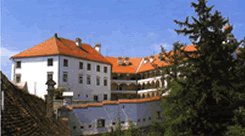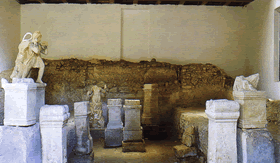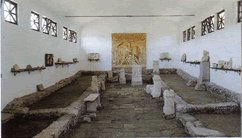 Ptuj
is the cultural, administrative, economic, employment, educational, and
traffic centre of the wider region. The city developed at the junction of
Slovenske gorice, Dravsko polje, and Ptujsko polje and also covers the area
of Haloze to the south. According to the 1997 figures, the City Municipality
of Ptuj has 32,043 residents and covers about 118 km2. It lies 232 meters
above sea level and has an average temperature of 9× C and an annual
average precipitation of 890 mm. After World War II, the city developed from
a small rural town, and with its growth individual areas of the city took
shape such as the old city centre where extensive renovations have been
made, new parts of the city with apartment buildings and individual
residences, industrial areas, and so forth. Because of their historical
significance, many buildings in Ptuj are protected as monuments. Near the
city, the largest reservoir in Slovenia has been formed by a dam on the
Drava River.
Ptuj
is the cultural, administrative, economic, employment, educational, and
traffic centre of the wider region. The city developed at the junction of
Slovenske gorice, Dravsko polje, and Ptujsko polje and also covers the area
of Haloze to the south. According to the 1997 figures, the City Municipality
of Ptuj has 32,043 residents and covers about 118 km2. It lies 232 meters
above sea level and has an average temperature of 9× C and an annual
average precipitation of 890 mm. After World War II, the city developed from
a small rural town, and with its growth individual areas of the city took
shape such as the old city centre where extensive renovations have been
made, new parts of the city with apartment buildings and individual
residences, industrial areas, and so forth. Because of their historical
significance, many buildings in Ptuj are protected as monuments. Near the
city, the largest reservoir in Slovenia has been formed by a dam on the
Drava River.
Numerous archaeological remains prove that the city experienced its first period of prosperity as the Roman town of Poetovio. The present much admired appearance of the city originated during the Middle Ages when Ptuj experienced its second rise to wealth and prominence. The castle, the Dominican and Minorite monasteries, the Provost Church, the old City Hall, the patrician houses, numerous marvellously carved doors, wrought iron window grills, and stonecutting details are the most important elements testifying to the spiritually and materially rich life of our forefathers in this region. The heritage of past centuries will enchant even the most demanding visitor to Ptuj, the oldest city in Slovenia.
A glance inside the museum, galleries, libraries, archives, theatre, and the National Center reveals many centuries of cultural heritage linked to modern life. The old compositions, the new art studios, and the theatre performances that take place in the unique ambience of cloisters, courtyards, loggias, and cobblestone streets-all these offer us an interesting fragment of the life in our city. But Ptuj is not merely a city with stories from the past. Maybe it is true that the most beautiful pictures of Ptuj were already painted and the most remarkable houses already built, but many important creators also gathered in Ptuj in the 20th century to contribute to the new appearance of the city.
 In
1830 the Ptuj curate Simon Povoden had Roman stone monuments built into
the base of the town's tower, thus creating the oldest, open-air museum in
Slovenia. To the locals it was known as the "sub divo"
(open-air) museum, but in honour of its founder it is now called the
Povoden Musem. In 1893 the members of the Tourist Society of Ptuj founded
a Museum Society. Their intention was to prevent the transfer of valuable
excavated archaeological material from Ptuj to Graz or Vienna. The first
collection, in the premises of the grammar school in present-day Prešernova
Street, originally comprised only archaeological objects; but in 1895
Professor Franz Ferk donated an extensive private collection, consisting
of museum objects of various types. As a result of this valuable donation,
the museum was renamed the Municipal Ferk Museum. In 1899 and 1914, the
sites of Mithras Shrine I in Spodnja Hajdina and Mithras Shrine III in
Zgornji Breg, respectively, were arranged for presentation. By 1987
archaeologists had discovered evidence of five Mithras Shrines; however
Mithras Shrines I and III are still the favourites with visitors. The
museum's collections were cramped in the grammar school, so in 1926 the
municipality bought the former Dominican monastery which had been
dissolved by Joseph II' s reforms (in 1786). The premises were renovated
and two years later they were occupied by the museum's collections. In
1945 the museum was entrusted with the management of the castle complex of
buildings, in which the furnishings of the last owners - the Herbersteins
- had been preserved almost completely. The library and archives became
independent institutions in 1954 and 1955 respectively, while the museum
extended the geographical scope of its activities and was renamed the
Regional Museum Ptuj in 1963. Today the museum covers the wider area of
Ptuj and Ormož.
In
1830 the Ptuj curate Simon Povoden had Roman stone monuments built into
the base of the town's tower, thus creating the oldest, open-air museum in
Slovenia. To the locals it was known as the "sub divo"
(open-air) museum, but in honour of its founder it is now called the
Povoden Musem. In 1893 the members of the Tourist Society of Ptuj founded
a Museum Society. Their intention was to prevent the transfer of valuable
excavated archaeological material from Ptuj to Graz or Vienna. The first
collection, in the premises of the grammar school in present-day Prešernova
Street, originally comprised only archaeological objects; but in 1895
Professor Franz Ferk donated an extensive private collection, consisting
of museum objects of various types. As a result of this valuable donation,
the museum was renamed the Municipal Ferk Museum. In 1899 and 1914, the
sites of Mithras Shrine I in Spodnja Hajdina and Mithras Shrine III in
Zgornji Breg, respectively, were arranged for presentation. By 1987
archaeologists had discovered evidence of five Mithras Shrines; however
Mithras Shrines I and III are still the favourites with visitors. The
museum's collections were cramped in the grammar school, so in 1926 the
municipality bought the former Dominican monastery which had been
dissolved by Joseph II' s reforms (in 1786). The premises were renovated
and two years later they were occupied by the museum's collections. In
1945 the museum was entrusted with the management of the castle complex of
buildings, in which the furnishings of the last owners - the Herbersteins
- had been preserved almost completely. The library and archives became
independent institutions in 1954 and 1955 respectively, while the museum
extended the geographical scope of its activities and was renamed the
Regional Museum Ptuj in 1963. Today the museum covers the wider area of
Ptuj and Ormož.
|
|
|
The hall has two, two-light windows: the southern one is Romanesque and semicircular, the northern one Gothic and ogival. The eastern wall of the cloister was painted with sacral and grave motifs. Prominent among the paintings is a picture of Dominicans kneeling and praying in two rows in front of a large figure of Christ in the mandorla. The cloister, one of the main architectural highlights of the monastery, was vaulted in the first half of the 15th century. On the inside the ribbed vaults rest on richly carved corbels and meet in figural keystones in their apexes. Around 1700 the monastery's refectory was adorned with rich stucco ornaments and paintings. In the early 18th century the old, "long choir" was demolished, the high altar moved to the western end of the church, and its eastern facade decorated with rich stucco . |
|
MITHRAS SHRINE I. IN SPODNJA HAJDINA
|
|
A youth's torso with a dagger in the left hand and a torch in the right, rises from a rock mass with a snake coiled around it, symbolising earth. The principal section of the temple is the pillared altar with a sculpture of a bull-slayer, dedicated to the transition (transitu). The statue of Mithras, in Persian dress and drawing a bull to be sacrificed, as well as the base with its dedication inscription are cut from a single stone block. |
|
MITHRAS SHRINE IiI. IN ZGRONJI BREG
|
|
On the right side is the sun god, on the left a male figure with the horn of affluence in his right hand and a patera in his left. Beside the original furnishings of the temple, there is also a relief dedication stone to the August Nurses (Nutrices avgustae), a female bust of the goddess of fertility (Magna Mater), an altar-piece from the Mithras Shrine in Modric on the Pohorje, and a stone with a relief of Saxan - the patron saint of the stone masons from Šmartno na Pohorju. |
ROMAN BRICKWORKS KILN
|
|
|
The works were built close to a deposit of excellent clay and it was usual to join several kilns, sheds for drying the products, and wells. In the kilns (over 80 were discovered) various earthenware products were fired (paving stones, bricks, vessels and oil lamps), often marked with stamps of the craftsmen who had made them (AEMILIVS, CRESCE, OCTAVI, INV FIRM, CIA, CAS(siae), CRI(spinae), ...). |
![]() Slovenski
trg (Slovene Square) in the centre of Ptuj, is the scene of an open air
lapidary collection, the oldest in Slovenia. This collection was named
after curate Simon Povoden who, in 1830, determined that collected
classical stone memorials should be built into the inner walls of the
municipal tower. Among them are pieces of civil and military tombstones,
urns, sacrifice altars, relief votive slabs and ashlars. The northern wall
of the tower contains, among others, the military tombstone of Gaius
Rufius, a soldier of the XIII. Gemina legion, and that of Gaius Cornelius
Verus, a veteran of the II. Adiutrix legion. A votive ashlar, devoted to
the Eastern deity Serapis, was built into the corner of the wall. Six
memorials were built into the southern wall of the tower. Among them are a
sacrificial altar, dedicated to Jupiter and decorated at the top with a
Norican-Pannonian volute, and the tombstone of Marcus Ulpius Cutius and
his family. The inscription states the dimensions of the grave: 20 x 20
feet. Most memorials were built into the eastern inner walls and, also
built within the walls, the stairway with a landing. To the right of the
stairway is a relief slab showing a chair of honour - probably connected
with some high civil servant. At the top of the stairway is a stone lion,
beneath it is a vaulted lintel bearing inscriptions on both sides. To the
left is a sacrificial altar dedicated to Mar(i)mogius, a war god, and to
the right a sacrificial altar to the sun god. In the bottom section of the
stairway is, among others, a slab with a relief of three men (Vicomagistri)
performing a ritual sacrifice. Next to it is a large fragment of a 2nd
century votive relief dedicated to the August Nurses (Nutrices avgustae).
The bottom of the stairway is adorned with two ashlars. The right one
shows a relief of the Genius of Autumn; the left one shows the Genius of
Spring and Hora, the goddess of summer. To the Povoden Museum also belong
the sacrificial altars, dedicated to Jupiter - the supreme god, which are
arranged in niches within the northern wall of the church of St Jurij.
Slovenski
trg (Slovene Square) in the centre of Ptuj, is the scene of an open air
lapidary collection, the oldest in Slovenia. This collection was named
after curate Simon Povoden who, in 1830, determined that collected
classical stone memorials should be built into the inner walls of the
municipal tower. Among them are pieces of civil and military tombstones,
urns, sacrifice altars, relief votive slabs and ashlars. The northern wall
of the tower contains, among others, the military tombstone of Gaius
Rufius, a soldier of the XIII. Gemina legion, and that of Gaius Cornelius
Verus, a veteran of the II. Adiutrix legion. A votive ashlar, devoted to
the Eastern deity Serapis, was built into the corner of the wall. Six
memorials were built into the southern wall of the tower. Among them are a
sacrificial altar, dedicated to Jupiter and decorated at the top with a
Norican-Pannonian volute, and the tombstone of Marcus Ulpius Cutius and
his family. The inscription states the dimensions of the grave: 20 x 20
feet. Most memorials were built into the eastern inner walls and, also
built within the walls, the stairway with a landing. To the right of the
stairway is a relief slab showing a chair of honour - probably connected
with some high civil servant. At the top of the stairway is a stone lion,
beneath it is a vaulted lintel bearing inscriptions on both sides. To the
left is a sacrificial altar dedicated to Mar(i)mogius, a war god, and to
the right a sacrificial altar to the sun god. In the bottom section of the
stairway is, among others, a slab with a relief of three men (Vicomagistri)
performing a ritual sacrifice. Next to it is a large fragment of a 2nd
century votive relief dedicated to the August Nurses (Nutrices avgustae).
The bottom of the stairway is adorned with two ashlars. The right one
shows a relief of the Genius of Autumn; the left one shows the Genius of
Spring and Hora, the goddess of summer. To the Povoden Museum also belong
the sacrificial altars, dedicated to Jupiter - the supreme god, which are
arranged in niches within the northern wall of the church of St Jurij.

 In
1230 Mehtildis, the widow of Friedrich III of Ptuj, donated to the
Dominicans - after obtaining the approval of the Archbishop of
Salzburg - land on the western edge of Ptuj. One year later monks
from Friesach (Carinthia) had already moved to the partly built
monastery. The principal activities of the Dominicans in Ptuj were
preaching, pastoral care, economic operations and education and they
also had a rich library. The monks inhabited the monastery until
1785 when it was dissolved by the reforms of Joseph II; later, it
was occupied by soldiers and craftsmen. In 1926 the monastery was
bought by the municipality and renovated for the municipal museum
and also for housing purposes. The renovation works discovered, both
historically and artistically, the most interesting parts of the
monastery. In the autumn of 1928 the newly arranged museum
collections were opened to the public. Soon after the foundation of
the monastery the eastern and southern wings of the cloister and the
church were built, to which - in the mid-13th century - a new
presbytery was added in the form of a long choir; one of the first
in Central Europe. Since the monastery's foundation, the entrance
wall of the Chapter Hall has been preserved.
In
1230 Mehtildis, the widow of Friedrich III of Ptuj, donated to the
Dominicans - after obtaining the approval of the Archbishop of
Salzburg - land on the western edge of Ptuj. One year later monks
from Friesach (Carinthia) had already moved to the partly built
monastery. The principal activities of the Dominicans in Ptuj were
preaching, pastoral care, economic operations and education and they
also had a rich library. The monks inhabited the monastery until
1785 when it was dissolved by the reforms of Joseph II; later, it
was occupied by soldiers and craftsmen. In 1926 the monastery was
bought by the municipality and renovated for the municipal museum
and also for housing purposes. The renovation works discovered, both
historically and artistically, the most interesting parts of the
monastery. In the autumn of 1928 the newly arranged museum
collections were opened to the public. Soon after the foundation of
the monastery the eastern and southern wings of the cloister and the
church were built, to which - in the mid-13th century - a new
presbytery was added in the form of a long choir; one of the first
in Central Europe. Since the monastery's foundation, the entrance
wall of the Chapter Hall has been preserved. The
oldest temple of Mithras in Rome's Danubian provinces was
discovered in the western area of Roman Poetovio, which is in
present-day Spodnja Hajdina. It was unearthed by the
archaeologist Dr. Wilhelm Gurlitt in 1898/99 and a protective
shed was erected over the temple immediately after its
discovery. Votive inscriptions indicate that the temple was
erected in the mid-2nd century by Illyrian customs officers who
were based in Poetovio. The temple was partially dug into the
soft slope and covered with a willow wattle structure. The
temple is divided into an anteroom and a central area with three
sections, of which the central one is lowered. In the western
wall of the central area a niche is preserved, into which the
main altar-piece was built. The central temple area contains 12
votive stones with inscriptions and reliefs depicting, among
others, myths and attributes connected with the individual
degrees of promotion of the dedicators. At the entrance to the
central room stand two sacrificial altars, dedicated to Cautes
and Cautopates, the deities of the East and West. The central
lowered area has several sacrificial altars and on one of them
is a full-size sculpture representing the birth of Mithras.
The
oldest temple of Mithras in Rome's Danubian provinces was
discovered in the western area of Roman Poetovio, which is in
present-day Spodnja Hajdina. It was unearthed by the
archaeologist Dr. Wilhelm Gurlitt in 1898/99 and a protective
shed was erected over the temple immediately after its
discovery. Votive inscriptions indicate that the temple was
erected in the mid-2nd century by Illyrian customs officers who
were based in Poetovio. The temple was partially dug into the
soft slope and covered with a willow wattle structure. The
temple is divided into an anteroom and a central area with three
sections, of which the central one is lowered. In the western
wall of the central area a niche is preserved, into which the
main altar-piece was built. The central temple area contains 12
votive stones with inscriptions and reliefs depicting, among
others, myths and attributes connected with the individual
degrees of promotion of the dedicators. At the entrance to the
central room stand two sacrificial altars, dedicated to Cautes
and Cautopates, the deities of the East and West. The central
lowered area has several sacrificial altars and on one of them
is a full-size sculpture representing the birth of Mithras. The
biggest temple of Mithras was erected in the western area of
Roman Poetovio (in what is today Zgornji Breg), in what was a
densely built-up residential area in Roman times. It was
discovered by Viktor Skrabar and dr. Mihovil Abramic in 1913.
The discovery was preserved under a protective structure,
erected in the following year, and financed by the voluntary
contributions of the then Museum Society. The temple, built in
the mid-3rd century, contains mainly sacrificial altars, with
dedications of soldiers belonging to the XIII. Gemina and V.
Macedonica legions under the command of Flavius Aprus. The
temple consists of three sections, of which the central one is
lowered. On the wall opposite the entrance is a fresco, a copy
of the altar relief from the Mithras Shrine in Osterburken in
Germany. The dedication stones show a variety of artistic
representations and are full of symbols relating to the legend
of Mithras. They are arranged in the lowered central area. On
one of the memorials, two male figures appear on the front side,
taking an oath over the fire on the sacrificial altar. To the
right side of the memorial, Mithras is shown shooting an arrow
of water from a rock - for the thirsty. On the left altar, the
birth of Mithras from a rock is shown above the inscription.
Beside Mithras, who holds a dagger in his left hand and a torch
in his right, stand Cautes and Cautopates, while above Mithras
the supreme god and the winged goddess of victory are depicted.
On the opposite side stands a high altar with lions couchant at
the top.
The
biggest temple of Mithras was erected in the western area of
Roman Poetovio (in what is today Zgornji Breg), in what was a
densely built-up residential area in Roman times. It was
discovered by Viktor Skrabar and dr. Mihovil Abramic in 1913.
The discovery was preserved under a protective structure,
erected in the following year, and financed by the voluntary
contributions of the then Museum Society. The temple, built in
the mid-3rd century, contains mainly sacrificial altars, with
dedications of soldiers belonging to the XIII. Gemina and V.
Macedonica legions under the command of Flavius Aprus. The
temple consists of three sections, of which the central one is
lowered. On the wall opposite the entrance is a fresco, a copy
of the altar relief from the Mithras Shrine in Osterburken in
Germany. The dedication stones show a variety of artistic
representations and are full of symbols relating to the legend
of Mithras. They are arranged in the lowered central area. On
one of the memorials, two male figures appear on the front side,
taking an oath over the fire on the sacrificial altar. To the
right side of the memorial, Mithras is shown shooting an arrow
of water from a rock - for the thirsty. On the left altar, the
birth of Mithras from a rock is shown above the inscription.
Beside Mithras, who holds a dagger in his left hand and a torch
in his right, stand Cautes and Cautopates, while above Mithras
the supreme god and the winged goddess of victory are depicted.
On the opposite side stands a high altar with lions couchant at
the top. The
eastern part of ancient Poetovio, nowadays a modern residential
quarter, was the crafts quarter of the Roman town. In 1974
archaeologists discovered a Roman brickworks kiln, one of nine
belonging to a major pottery workshop and brickworks. The kiln was
first displayed at the site itself in 1982. It is brick-built and
the vaults and bottom section of the kiln, as well as the covered
fire pit, are preserved. The crafts quarter was discovered and
researched by archaeologists in the 1970's and 80's and 90's. The
quarter extended along the Aquileia-Savaria imperial road. To the
north and south of the road, large buildings with living quarters
and shops were discovered, as well as big workshops, drying sheds
and courtyards. In the centre of the quarter were living quarters
furnished with frescoes, stucco and mosaics and heated by
hypocausts. Various workshops were unearthed in the quarter: those
of stone-carvers, smiths, potters; and brickwork kilns for burning
lime. Pottery workshops and brickworks prevailed among them.
The
eastern part of ancient Poetovio, nowadays a modern residential
quarter, was the crafts quarter of the Roman town. In 1974
archaeologists discovered a Roman brickworks kiln, one of nine
belonging to a major pottery workshop and brickworks. The kiln was
first displayed at the site itself in 1982. It is brick-built and
the vaults and bottom section of the kiln, as well as the covered
fire pit, are preserved. The crafts quarter was discovered and
researched by archaeologists in the 1970's and 80's and 90's. The
quarter extended along the Aquileia-Savaria imperial road. To the
north and south of the road, large buildings with living quarters
and shops were discovered, as well as big workshops, drying sheds
and courtyards. In the centre of the quarter were living quarters
furnished with frescoes, stucco and mosaics and heated by
hypocausts. Various workshops were unearthed in the quarter: those
of stone-carvers, smiths, potters; and brickwork kilns for burning
lime. Pottery workshops and brickworks prevailed among them.